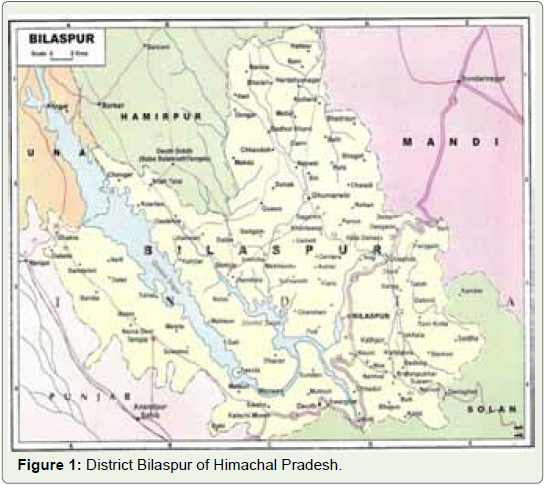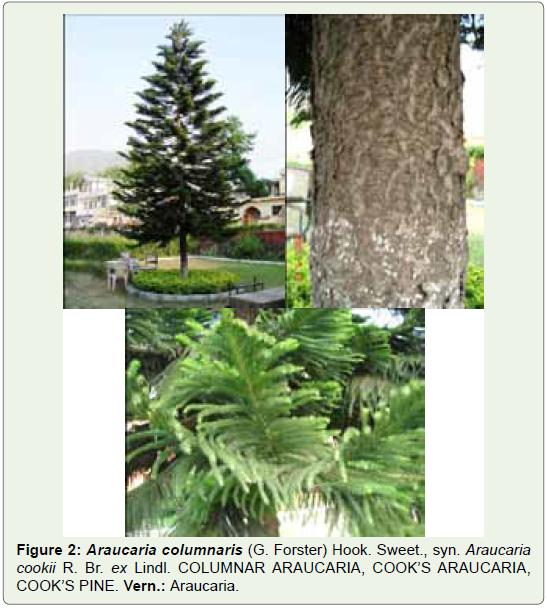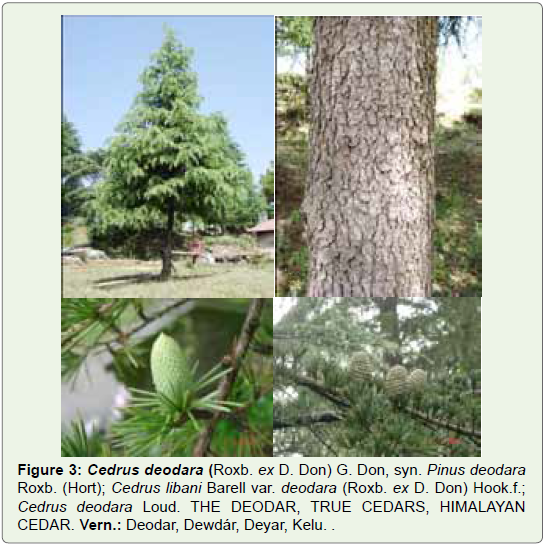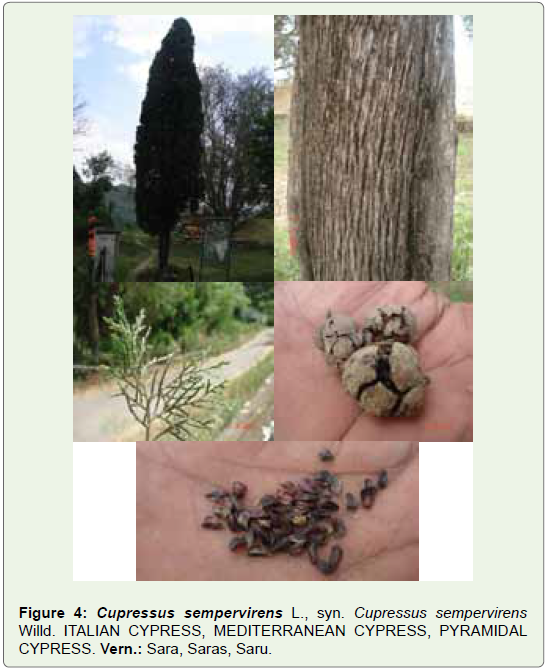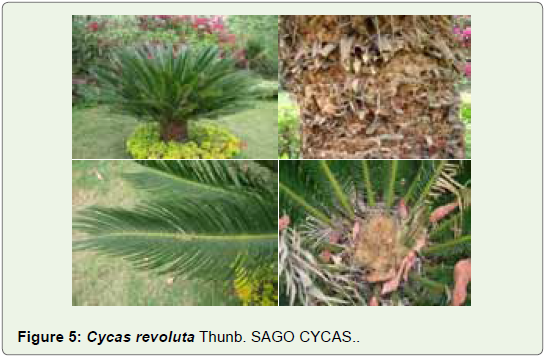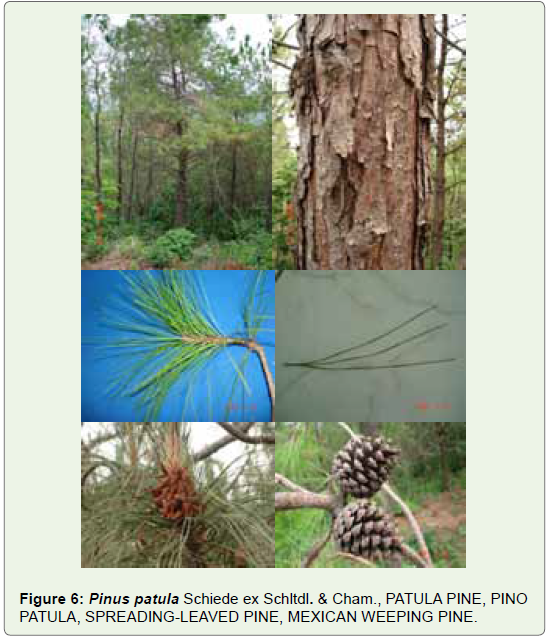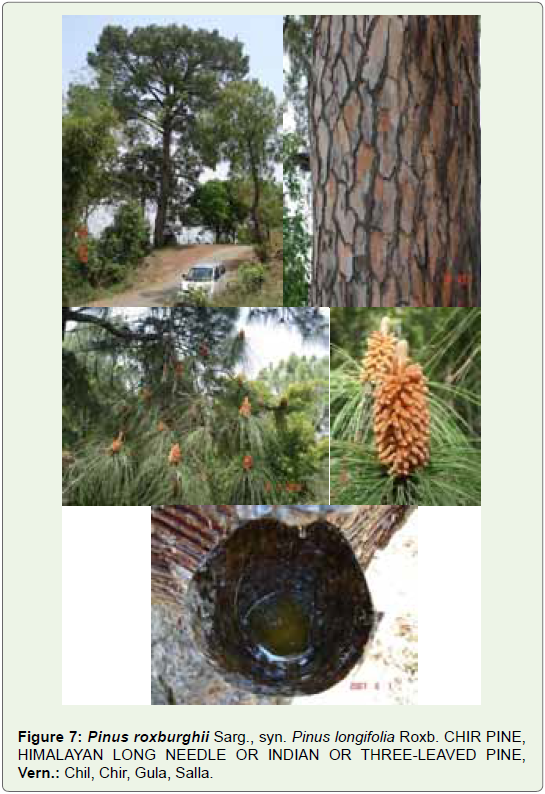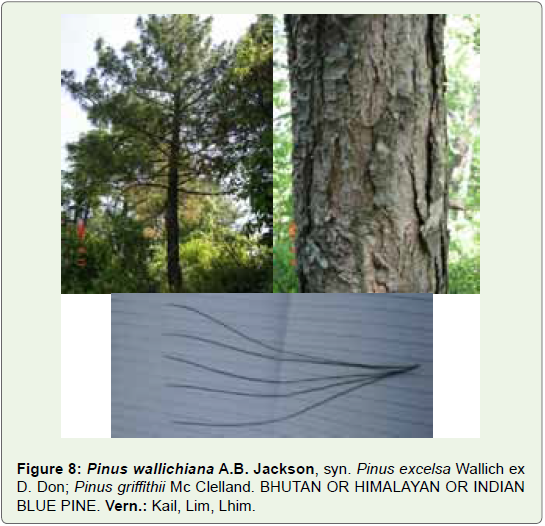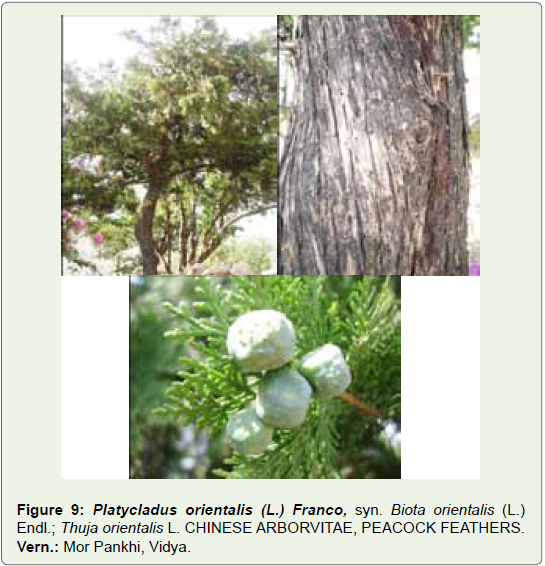Research Article
Gymnosperms of District Bilaspur of Himachal Pradesh, India
Kumar M*
Department of Botany, Govt.College Ghumarwin, District Biaspur, India
*Corresponding author: Mahender K, Associate Professor, Department of Botany, Govt.College Ghumarwin, District
Biaspur, (H.P.) Pin- 174021, Tel: Phone No. 9418202629; Email: mahender2629@gmail.com
Copyright: © Kumar M. 2021. This is an open access article distributed under the Creative Commons Attribution License, which
permits unrestricted use, distribution, and reproduction in any medium, provided the original work is properly cited.
Article Information: Submission: 01/10/2020; Accepted: 28/05/2021; Published: 31/05/2021
Abstract
Spermatophytes are the seed bearing plants which are divided into gymnosperms and angiosperms. Gymnosperms, a group of naked seed bearing
plants, have 83 genera and 1079 species (Shu- Miaw Chaw, Edi Sudianto, in Advances in Botanical Research, 2018). To the best of my knowledge it is the
first quantitative study of diversity of gymnosperms of this district. During the field survey, eight different species of gymnosperms viz. Araucaria columnaris,
Cedrus deodara, Cupressus sempervirens, Cycas revoluta, Pinus patula, Pinus roxburghii, Pinus wallichiana and Platycladus orientalis have been collected
and identified from the District Bilaspur of Himachal Pradesh. These species of gymnosperms are known to have economic, ecological and ethnobotanical
importance. The present study and survey are important with respect to the diversity of gymnosperms and their uses. This effort may awaken the local
people, to be more conscious about the plant wealth as well as its sustainable use.
Introduction
Gymnosperms are the plants with naked ovules. The main
objective of this paper is to identify the gymnosperms of the District
Bilaspur of Himachal Pradesh. Their systematics, common names,
vernacular names, citations, morphological characteristics, flowering
(Cones/Strobili) and seed seasons, places of collection, habitat, their
distribution in the World, India, and in Himachal Pradesh along with
economic importance are mentioned in this paper.
Bilaspur is the second smallest and one of the twelve districts
of Himachal Pradesh (Figure 1). This is situated in Shivalik Hills
of Western Himalayas. The river Satluj flows through the district
Bilaspur for about 90 KM. This river enters the district Bilaspur at
KARAHI KA GHARAT near the village Kasol (now- a- days famous
for Kol Dam) and leaving it at the village NEILA near the Bhakhra
Dam. Having an area of 1167 Sq. Km. its altitude varies from 290
to 1980 meters from the mean sea level. It is known for its climatic,
geographical and floral diversity.
Materials and Methods
Extensive field survey of the District Bilaspur was carried
out during different seasons for exploring the various species of
gymnosperms. Standard procedures were followed for the collection,
preservation and identification of gymnosperms. Important characters
of gymnospermic plants were noted and their coloured photographs
were taken in the field. Herbarium mounts were prepared for record
and identification. For describing and identifying the plants, we
have followed the terminologies used by Harris and Harris (1994),
Jain and Rao (1977), Polunin and Stainton (1984), Stainton (1988)
and Womersley (1981). Their nomenclature is in accordance with
the International Code of Nomenclature (ICN), International Plant
Names Index (IPNI) and The Plant List (2013). The Natural System
of Classification of Spermatophytes, given by Bentham and Hooker
(1862-1883) and Hooker (1872-1897) along with latest amendments (Chase and Reveal, 2009) has been followed in
this paper. The identified gymnospermic plants have been described
alphabetically.
Observations
Extensive survey of the district Bilaspur during different seasons
has been carried out from 2011 to 2014. A total of 08 species
belonging to 06 genera and 04 families have been reported from the
territory of this district. 07 species of gymnosperms are reported to be
timber yielding, 04 species as ornamental while single species (Cycas)
is the source of sago. Pinaceae is the most dominant family with four
genera, Cupressaceae represented by two genera while one genera
each in case of Araucariaceae and Cycadaceae.
Pinus patula has been reported for the first time from this
region. Two plants of Cedrus deodara are growing successfully at an
altitude of 375 meters in the nursery garden of ACC Ltd. Barmana.
Dense forest of Cedrus deodara and Pinus wallichiana is reported at
Bahadurpur (1980 meters). Pinus roxburghii is the dominant species
of gymnosperms of this area. This species is abundant in Swarghat,
Ghumarwin, Bharari, Jhandutta and Kalol Forest Ranges. However it
is less abundant in Sadar Forest Range. Araucaria, Cupressus, Cycas
and Platycladus are the ornamental gymnosperms of the area.
Results and Dicussions
Eight different species of gymnosperms viz. Araucaria columnaris,
Cedrus deodara, Cupressus sempervirens, Cycas revoluta, Pinus
patula, Pinus roxburghii, Pinus wallichiana and Platycladus oriental
are collected and identified from the District Bilaspur of Himachal
Pradesh. These are described below:
1. Araucaria columnaris (G. Forster) Hook. Sweet.Hort. Brit. ed.
2: 475. 1830; Bot. Mag. 78: t. 4635. 1852. Dallimore & Jackson, Hbk.
Conif. & Ginkgo. 113. 1923; Raizada & Sahni, Living Ind. Gymno. Ind.
For. Rec. (n.s.) Botany 5 (2): 108. t. IV. f.2. 1960; Keeth & Rushforth,
Conifers, 90. 1987; Sahni, Gymno. Ind. & Adj. Countr. 53. t.8. f.2.
1990; Gaur. Fl. Garh. NW. Himal. 52. 1999.syn. Araucaria cookii R.
Br. Ex Lindl. Family Araucariaceae. COLUMNAR ARAUCARIA,
COOK’S ARAUCARIA, COOK’S PINE. Vern.: Araucaria. Figure 2.
Figure 2: Araucaria columnaris (G. Forster) Hook. Sweet., syn. Araucaria
cookii R. Br. ex Lindl. COLUMNAR ARAUCARIA, COOK’S ARAUCARIA,
COOK’S PINE. Vern.: Araucaria.
A tree, 30-61 m high, with the peculiar habit of shedding its lower
branches and replacing them by short shoots from adventitious buds
producing the effect of a dense green column that widens out within a
short distance of the apex. Crown is columnar. Branches horizontal,
lateral branchlets long, slender whip-like. Outer bark shedding off
in thin papery layers. Leaves on older shoots broadly ovate, 0.2-0.4
x 0.12 cm, pointed, rigid, closely overlapping and curving inwards,
on juvenile shoots triangular or lance shaped, up to 0.5-0.7 cm long,
pointed. Male Strobili (Catkins) 2.5-7 cm long, 0.5-0.1 cm wide,
set in a cup-like arrangement of leaves. Female Cones ellipsoid, 12-
15 cm long, 9-11 cm wide, teasel-like when partly developed owing
to the scale appendages, scales ca 3.3 cm in across, with a central
seed margined by well developed wings, scales about 1.5 cm across
with a central seed margined by well-developed wings, each 1.5 cm
wide, terminal spines about 1.8-2 cm long. Flowering and Fruiting:
February-May.
Specimens examined: Bilaspur, 25 July, 2011, Mahender. 192,193.
Habitat: A low land, fast growing tree grows well in exposed and
dry slopes and plains. It is also grown for decorative purposes, in
house lawns and gardens.
Distribution: Native to New Caledonia and Polynesia. It was
discovered by Captain Cooke during his voyage in the Pacific. It is
widely introduced in the sub-continent. India: Throughout India,
cultivated for ornamental purposes. Altitude: 400-1500 m.
Economic and Ethnobotanical Uses: It is a popular landscape
tree and is widely cultivated as ornamental plant in houses, gardens
and various Government and Private Institutions [35,38]. Wood is
used for carpentry work [2] (Ambasta, 1986; Raizada and Sahni, 1960;
and Sahni, 1990).
2. Cedrus deodara (Roxb. ex D. Don) G. Don in Loud. Hort. Brit.
Ed. 388. 1830; Troup, Silvi. Ind. Trees III: 1096. f. 445-448. 1921;
Raizada & Sahni, Living Ind. Gymno. Ind. For. Rec. (n.s.) Botany 5
(2): 129. f.9. t. VIII. f.4. 1960; FBH. 2. 1977; Polunin & Stainton, Fls.
Himal. 386. f.510. 1984; Naithani, Fl. Chamoli 2: 762. 1985; Stainton,
Fls. Himal. Supplement 59. t.112. f.499. 1988; Sahni, Gymno. India &
Adj. Countr. 86. t.13. f.1. 1990; FLS. 580. 1994; FK. 707. 1999; Gaur, Fl.
Garhwal. 51. 1999; FGHNP. 269. 2000; FSIR. 698. 2004; FC. 830. 2006.
Pinus deodara Roxb. (Hort. Beng. 69. 1814, nom.nud.) ex D. Don in
Lamb. Descr. Genus Pinus 2: 8. 1824; Roxb., Fl. Indica. ed. 2.3. 651.
1832. Cedrus libani Barell var. deodara (Roxb. ex D. Don) Hook.f. in
Himal. J. 1: 257. 1854; FBI. 5: 653. 1888; FS. 486. f.159. 1902, 1921; PP.
40. 1916. Cedrus deodara Loud. Stewart. PP. 220. 1869; Kanjilal, For.
Fl. Chakrata, Dehradun & Sharanpur. 549. 1901; Brandis, Ind. Trees.
691. 1906; FF. 544. 1918. Family Pinaceae. THE DEODAR, TRUE
CEDARS, HIMALAYAN CEDAR. Vern.: Dedwar, Deodar, Dewdár,
Deyar, Geyar, Kalain, Kalon, Kelu, Kilan, Kilankaper (Figure 3).
Figure 3: Cedrus deodara (Roxb. ex D. Don) G. Don, syn. Pinus deodara
Roxb. (Hort); Cedrus libani Barell var. deodara (Roxb. ex D. Don) Hook.f.;
Cedrus deodara Loud. THE DEODAR, TRUE CEDARS, HIMALAYAN
CEDAR. Vern.: Deodar, Dewdár, Deyar, Kelu.
A long-living, very large, evergreen tree up to 80-90 m in height
and 12-15 m in girth, young trees cone-like in appearance, but old ones
usually with rounded and flattened tops. Bark green or gray, thin and
smooth on young trees, but 0.5-3 cm thick, dark grayish brown, dark
brown, sometimes reddish or black, divided into irregular oblong
scales or plates with vertical as well as diagonal cracks, quite rough,
deeply furrowed in old stems. Blaze is 3.8-5 cm, pinkish brown.
Branches are irregular, horizontal, slightly ascending, descending
or spreading, never in whorls, leading shoots and tips of branches
usually drooping. Young or New shoots with pale green leaves appear
in March or early April and are covered with grayish down. Shoots
(Branchelets) dimorphic. Long shoots or shoots of unlimited growth
long, slender, bearing scaly leaves, spirally arranged foliar leaves and
dwarf shoots. Dwarf shoots or shoots of limited growth are short,
thick, bearing tufts of leaves (15-20) in pseudo whorls. Every year it
elongates slightly and a new whorl of leaves is added, successive years of growth being marked by a ring of re-curved bud scales; sometimes
bears flowers or occasionally develop into long shoots. Winter buds
small, ovoid, with brown scales, which persist on the shots even after
the appearance of young leaves. Leaves dark green, 2.5-5 cm long,
acicular, stiff or rigid, sharply pointed, triquetrous (3-sided), glaucous
or silvery, amphistomatic with two rows of marginal resin canals
on the inner surface, persistent, lasting 1-6 years. Leaf shedding
occurs in May or sometimes in October-November at the time of
cone ripening. Strobili (cones or flowers) solitary, erect, terminal
borne on short shoots, appearing in July-
August, maturing during
late September, unisexual and dioecious, sometimes monoecious, in
latter case, they are borne on separate branches. Male cones solitary,
terminal on dwarf shoots, oblong, ovoid or cylindrical, 2.5-4.5 cm
long and 1-1.5 cm in diameter, pale green when young, yellowish-
green with purplish tinge when mature, each consisting of numerous
microsporophylls (stamens) arranged spirally on a broad central
axis, each stamen with two abaxially placed, oblong microsporangia
or pollen sacs, the connective of which is produced into a flattened
ovate, obtuse, upturned, beak-
like appendage with an irregularly
crenulate margin. Depending upon the altitude, locality and season
male cones appear during March-June, and shed their pollens from
September to October. Before shedding, they elongate rapidly to
5-7.5 cm in length and turn yellow. Pollen grains are winged, golden.
Pollination occurs in October. Young Female strobili or cones
appear in August, erect, solitary, terminal on dwarf shoots, arising
progressively every year towards the terminal end on the upper side
of horizontal branches, scaly leaves of unequal sizes enclosing the
young cones, each consisting of a broad central axils on which are
present spirally arranged bract scales, in the axis of which are present
fan-shaped ovuliferous scales bearing two inverted ovules on the
adaxial surface. Many of the ovuliferous scales present at the base and
apex are sterile. At the time of pollination the cones are difficult to
find as they are inconspicuous
and partly hidden by rosettes of leaves.
They are narrowed to a claw-like process at the base, bract scales
often enlarging after flowering time and larger than the ovuliferous
scales. They are pale glaucous green, oblong or ovoid, 1.2-2 cm long
and 0.6 cm in diam. They are however, in an open state to receive
pollen grains, as the scales stand perpendicular to the axis and the
ovules are exposed. After pollination, the sporophylls grow slightly
and cone becomes compact and finally closes. Growth ceases until the
following spring, i.e. March of next year. By early part of May next,
they become barrel shaped and increase to 8-12 cm in length and
5-8 cm in diam, with fan shaped, 3-3.5 cm broad ovuliferous scales.
By the end of June or during July, they become full sized and are
pale bluishgreen.
During August they turn chocolate-brown, ripen
from September to November and finally turn woody and brown in
colour. Thus the time taken from the first appearance of the female
strobili to the ripening of cones is about 12½ - 13½ months. Ripe
(Mature) Female cones large, 10-15 cm by 7.5-10 cm, erect, barrelshaped,
ovoid, ellipsoidal or cylindrical, brown, resinous, on short
stout stalks, bracts minute or absent, ovuliferous scales woody, closely
overlapping, fan shaped with a basal stalk-like claw, breaking up on
the tree and shedding the winged seeds along with cone scales, the
central axis persisting for a long time on the tree. Seeds pale brown,
triangular, two to each ovuliferous scale, winged, each with a broad
membranous apical wing, 0.8-1.6 cm long (with wings 2.5-3.8 cm long), wings with round corners, larger than the seeds, being 1.7-
2.5 cm. Germination epigeous. Cotyledons 9-11. Seed shedding up
to December in certain localities. At the time of shedding, the cone
breaks up on the tree, the scales and seeds falling to the ground and
persistent woody axis remaining for years on the branches.
Specimens examined: 17 April, 2010, Mahender.
67, 68.
Habitat: Evergreen pyramidal shaped trees, typically gregarious,
often found in pure stands, common in temperate slopes, also found
in association with Picea smithiana and Pinus wallichiana, and
infrequently with oaks, maple, cherries, chestnuts and other broadleaved
species, often planted in hill stations in Europe, America and
other parts of the world. Distribution: Afghanistan, Asia Minor, Atlas
mountains (Africa, Algeria), Cyprus, Mediterranean mountains,
Nepal (Kurnauli valley), Pakistan (Chitral, Dir, Dungagale, Hazara,
Kagan valley, Thundi, Trans Indus), Syrian mountains, W. Himalayas.
India: Jammu & Kashmir, Uttarakhand (Almora, Chakrata, Jaunsar,
Kumaon, Mussoorie, Nainital, Ranikhet, Tehri-Garhwal).
Himachal Pradesh: Chamba (Dalhousie, Kala Top, Khajjiyar,
Pangi, Tisa), Kangra (Bara-Bangal, Chhota-Bangal, Dhauladhar
near Mc Cleodganj to Dharamkot, Palampur, Tathwani), Kinnaur
(Jangi, Kalpa, Nichar, Rundung, Ralli), Kullu (Bahu, Banjar, Chowai,
Jaloripass, Khanag, Kullu, Manali, Manikaran, Nagar, Pulga, Seraj),
Lahaul & Spiti (Kali, Miyarnala, Lahaul), Mandi (Junee, Karsog,
Mandi, Nachan, Suket), Shimla (Baghi, Bushahr, Boileauganj,
Chaajpur, Charabra, Chopal, Chota Shimla, Fagu, Glen, Jakhoo
Hills, Jubbal, Khadrala, Kharapathar, Kotgarh, Kufri, Mahasu,
Nankheri, Naldhera, Potter’s Hill, Rohru, Summer Hill, Tara Devi),
Solan (Kasauli, Solan), Sirmaur (Churdhar, Haipurdhar, Haban,
Nauradhar, Rajgarh). Altitude: 1200-3300 m.
Economic and Ethnobotanic Uses: The largest deodars are
usually found near temples, where they are venerated and protected
from injury. As an ornamental tree there are few trees in the World
that can be compared with deodar. In Ayurveda all parts are
considered bitter, hot, pungent, light oleagenous, useful in belching,
inflammations, dyspepsia, insomnia, hiccough, fever, urinary
discharges, ozoena, bronchitis, itching, elephantiasis, tuberculous
glands, leucoderma, ophthalmia, piles, disorders of the mind, diseases
of the skin and of the blood. The leaves lessen inflammation, applied
in tuberculous glands. Needles contain ascorbic acid and yield an
essential oil [24,27,34]. Its wood is the strongest, most valuable and
the best among coniferous woods. It is an important constructional
timber and is extensively employed for construction, beams, floor
boards, posts, cooperage, door and window frames, furniture,
packing cases, spars and shingles and railway sleepers. The average
life of sleepers is 15 years. It is also used for bridge construction,
wagon building, brush backs, carriages and several other purposes. It
is suitable for pattern making, poles for carrying high tension lines,
battery separators, and second grade pencils [2,40,41]. Wood is bitter,
diuretic, diaphoretic, carminative, expectorant, useful in rheumatism,
piles, palsy, epilepsy, stones in the kidney and bladder, prolapsusracti,
fever, flatulence, heart palpitations, paralysis, dropsy and urinary
diseases [27,34,43]. In gonorrhoea, syphilis, gout and rheumatism,
its decoction is given as a powerful alternative with turmeric and guggulu (Commiphora mukul) [47]. Due to the presence of oil,
seasoned heartwood is durable and is rarely attacked by white ants
and fungi [44]. In Kangra the wood is pounded with water on a
stone, and the paste is applied to temple to relieve headache [47]. The
wood on steam distillation yields an oleoresin and a golden yellow,
reddish brown or dark coloured essential oil known as Himalayan
Cedar wood oil with characteristic balsamic odour [27,43]. It has
been used since ancient times in Ayurvedic and Yunani systems of
medicine for the treatment of rheumatoid arthritis, ulcers and skin
diseases. It is also massaged in lumbago and urticaria. The oil is
used as a substitute for true cedar wood oil in soap perfumery, but
it is too expensive. It also shows anti-inflammatory activity. The oil
is analgesic, diaphoretic and alexipharmic, useful for bruises and
injuries to joints, boils, tuberculous glands, skin diseases. The bark
is used in diarrhoea and dysentery. Aqueous paste of bark is used in
bowel complaints and externally applied on piles [17,27,34]. (Simson
and Rau, 1922; Kirtikar and Basu, 1935; Raizada and Sahni, 1960;
Ambasta, 1986; Gaur, 1999; Joshi, 2000; Pullaiah, 2002; Seth, 2003,
2006; Sharma, 2003; and Singh and Kumar, 2000).
3. Cupressus sempervirens L. Sp. Pl. 1002, 1753; Kanjilal, For. Fl.
Chakrata, Dehradun & Saharanpur. 544. 1901; Brandis, Ind. Trees.
693. 1906; FF. 546. 1918; Troup, Silvi. Ind. trees III: 1161. 1921;
Raizada & Sahni, Living Ind. Gymno. Ind. For. Rec. (n.s.) Botany 5 (2):
143. t.IX. f.2. 1960; Dallimore& Jackson. Hbk. Conif. & Ginkgo. Rev.
Harrison 214. 1966; Sahni, Gymno. India & Adj. Countr. 109. t.22.
f.2. 1990.Cupressus sempervirens Willd. Stewart, PP. 222. 1869. Family
Cupressaceae. ITALIAN CYPRESS, MEDITERRANEAN CYPRESS,
PYRAMIDAL CYPRESS.
Vern.:
Sara, Saras, Saru. Figure 4.
Figure 4: Cupressus sempervirens L., syn. Cupressus sempervirens
Willd. ITALIAN CYPRESS, MEDITERRANEAN CYPRESS, PYRAMIDAL
CYPRESS. Vern.: Sara, Saras, Saru.
It is a tree of 20-30 m height, spreading habit like that of a cedar
or with erect branches nearly parallel to the stem having columnar
shaped crown. A very slow growing long- lived tree, an age of 2000-
3000 being on record. It has an erect trunk. Bark thin, smooth,
greyish- brown, fibrous and furrowed and fissured longitudinally.
Branches are ascending, not whorled. Branchlets alternate,
tripinnate, irregularly spreading, the ultimate division 4-angled, deep
green. Leaves in 4-equal ranks, blunt, often marked on the back with
a longitudinal furrow, closely adpressed tips, so that the branchlets
are not rough to the touch. Male strobili yellow, ca 2.5 mm long,
stamens in ca 10 pairs. Female cone solitary or few together, ca 3-4
cm in diameter; shining brown or greyish, sub- globose or ovoid
on short-curved stalks; scales 8-14, rising to a point in the centre
or flattened with a thin ridge-like process. Seeds8-20 on each scale,
ca 0.42 cm long, winged, without resin tubercles. The cones take 2
years to mature. It has 2 typical varieties, the spreading form var.
horizontalis and the pyramidal or columnar form var. sempervirens.
Flowering: Male strobili appear in August-October; ripening and
shedding January-February. Fruiting: Female cones ripen in the
second year. The cones open and shed from August-December.
Specimens examined: Auhar, 7 May, 2013, Mahender, 389.
Habitat: Grows wild in regions bordering the eastern
Mediterranean. In India it is widely planted as an ornamental plant
in gardens. Distribution: Asia Minor, Burma, Bulgaria, Cypress,
France, Greece, Italy, N. Persia, Portugal, Russia, Sicily, Spain,
Switzerland, Syria. India: Extensively cultivated in Agra, Dehradun,
Delhi, Srinagar, Shimla. Altitude: 924-2400m.
Economic and Ethnobotanical Uses: It is widely planted as an
ornamental tree [1]. Leaves yield an essential oil, which is used in
perfumery and in soaps; it is also used for whooping cough [27].
Wood is used for boxes, furniture and building purposes [2]. It is
astringent and anthelmintic. Seed oil is used for massaging in muscle
pains. Cones are anthelmintic and useful in piles [27]. (Kirtikar &
Basu, 1935; Ambasta, 1986; Agarwal, 2003).
4. Cycas revoluta Thunb. Fl. Japan 22, 1784; Brandis, Ind. Trees.
698. 1906; FF. 551. 1918; Raizada & Sahni, Liv. Ind. Gymnosperms.
Ind. For. Rec. (n.s.) Botany 5 (2): 94. t.1. f.1. 1960; Sahni, Gymno.
India & Adj. Countr. 26. t.1. f.1. 1990.Family Cycadaceae. SAGO
CYCAS. Figure 5.
A dioecious tree or shrub, 3-6 m tall, the largest known trees
8 m tall are seen in Tyugeji temple in Tokyo. Trunk is cylindrical,
with a crown of glossy, fern-like, stiff but gracefully revolute margin
of the pinnate leaves; covered with compacted woody bases of
petioles. Bark brown, smooth below, with scars of fallen leaflets.
Leaves pinnate, ovate, laciniate nearly to the midrib with 12-20
linear curved spinous segment or leaflets; short distant spines at right
angles to the petiole or slightly deflexed near the base ovate, 1.3-2
m long; petiole 0.3-0.5 m long; new leaves appear in March-April.
Leaflets are of 12-20 pairs, alternate 10-25 cm long, 5-9 mm wide,
blunt or acute, margins revolute. Male cone shortly peduncled c 23
cm long, 4-6 cm in diameter, male cones mature to 30 cm in length in
July; microsporophylls 2.5-4 cm long, 1-1.2 cm wide, ovate-deltoid,
prolonged into an up curved subulate spine, c 2 cm long, clothed with
a brown tomentum externally, glabrous above. Megasporophylls
forming as apical crown in a rosette form, densely hairy, stalk longer
than blade with 4-6 ovules that are covered with thick brown hairs.
Ovules 5-10 per megasporophyll. Seeds flattened, glabrous 1.5-3.5
cm long, apex emarginated, bright orange or yellow.
Specimens examined: Barmana, 4 April, 2008, Mahender. 13, 14.
Habitat: It is a slow growing, palm-like tree. This cycad is most
widely cultivated in gardens in the Indian subcontinent including
Sri Lanka. Distribution: China, S. Japan, Taiwan.India: Commonly
the female trees are found introduced in India. A few male trees are
planted in the Botanical Garden of the Forest Research Institute
Dehradun. Himachal Pradesh: Mostly cultivated as an ornamental
plant in gardens.
Economic and Ethnobotanic Uses: This cycad is most widely
cultivated in gardens as ornamental plant [2]. The pith yields Sago
and the seeds can be eaten being rich in protein. The leaves after
silvering are made into funeral wreaths. Root tubers contain starch
[2,35 ]. (Raizada and Sahni, 1960; and Ambasta, 1986).
5. Pinus patula Schiede ex Schltdl. & Cham., Linnaea 6: 354. 1831.
Family Pinaceae. PATULA PINE, PINO PATULA, SPREADINGLEAVED
PINE, MEXICAN WEEPING PINE. Figure 6.
Figure 6: Pinus patula Schiede ex Schltdl. & Cham., PATULA PINE, PINO
PATULA, SPREADING-LEAVED PINE, MEXICAN WEEPING PINE.
It is a large, evergreen tree, up to 40 m in height and 1 m in
diameter below breast height. Stem usually with a single, straight,
slender trunk; in closed canopy stands. First-order branches are long,
slender, spreading or slightly ascending; higher order branches are
slender, drooping, the ultimate branches pendent. The shoots are
rough and scaly when the leaf fascicles have fallen, yellow or redbrown,
foliage shoots with prominent, decurrent pulvini. Cataphylls
subulate, recurved at apex, scarious, with erose-cliate margins,
brown, early deciduous. Vegetative buds oblong-cylindrical; the
terminal bud 15-20 mm long; and the lateral buds shorter, brown,
not resinous. The scales are spreading, subulate, with ciliate margins.
Fascicle sheaths initially 20-30 mm long with 6-8 imbricate,
chartaceous, white-yellow or orange-brown scales, persistent but
shortening to 12-15 mm in mature fascicles, slowly weathering to
grey-brown. Bark is thin, scaly, red-brown on young trees; becoming
thick, dark grey-brown, rough and scaly with large elongated plates
and deep longitudinal fissures on mature plants. Leaves in fascicles of 3, sometimes 4-5, in drooping tufts, in two rows on either side of the upturned shoot, persisting for 2-3 years, thin, lax, drooping-pendent,
serrulate at the margins, acute, pale-dark green; triangular in outline;
stomata on all sides. MALE CONES crowded near the proximal end
of new shoots, spreading, subtended by scarious bracts, ovoid-oblong
to cylindrical, 15-20 x 5-6 mm, pink-yellow, finally yellow-brown.
FEMALE CONES sub-terminal or lateral in position, in whorls of
2 to many, rarely solitary, persistent or deciduous, peduncles up to
20 mm long. Young Cones are ovoid, on recurved peduncels with
persistent calaphylls, purple turning light brown, maturing in two
seasons. Mature Cones narrowly ovoid when closed slightly curved,
asymmetrical at base, 5-12x3-6 cm when open. Megasporophylls
100-150, serotinous or parting sometime after maturing, tenacious or
deciduous with the peduncle, woody, oblong, usually curved when
spreading, the proximal megasporophylls connate, purple-brown to
dark brown, with adaxial light brown marks left by the seed wings.
Apophysis is flat to slightly raised, transversely keeled, gibbous on
proximal sporophylls, rhomboid, upper margin acute or obtuserounded,
abaxial surface striate or smooth, lustrous or yellow-brown.
Umbo is dorsal, flat or raised, sunken into the apophysis, 3-7 mm
wide, grey, with a minute, deciduous prickle. Seeds obliquely ovoid,
flattened, 4-6x2-4 mm, dark grey. Seed wings articulate, held to the
seed by two oblique claws which partly cover the seed on one side,
obliquely ovate-oblong, 12-18x5-8 mm, light brown with dark stripes.
Specimens examined: Barmana, 23 May, 2009, Mahender. 130.
Distribution: Native of Mexico. It is planted at high altitudes in
Ecuador, Bolivia, Colombia, Kenya, Tanzania, Angola, Zimbabwe,
Papua New Guinea and Hawaii. At lower altitudes it is cultivated in S.
Brazil, S. Africa, India and Argentina. It has been introduced in New South Wales, Australia and in New Zealand. It is cultivated in United
Kingdom as an ornamental tree. India: Himachal Pradesh.
Economic and Ethnobotanic Uses: Wood is used as timber.
Needles are the source of green dye. Turpentine oil is used in the
treatment of kidney and bladder complaints as well as in rheumatic
affections. It is also beneficial in cough, cold, influenza and TB.
6. Pinus roxburghii Sarg., in Silva N. Amer. 2: 9.1897; Raizada &
Sahni in Ind. For. Rec. n.s. 5(2): 115. t.V. f.1. 1960; Stewart in Nasir
& Ali, Annot. Cat. Vasc. Pl. W. Pak. & Kashmir 25. 1972; FBH. 2.
1977; Polunin & Stainton, Fls. Himal. 388. f.511. 1984; Naithani, Fl.
Chamoli 2: 763. 1985; Stainton, Fls. Himal. Suppl. 60. t.113. 1988;
Sahni, Gymno. India & Adj. Countr. 66. t.10. f.1. 1990; FK. 708. 1999;
Gaur, Fl. Garhwal. 51. 1999; FGHNP. 270. 2000; FSIR. 699. 2004; FC.
833. 2006. Pinus longifolia Roxb., Fl. Ind. 3: 651.1832; Stewart, PP. 226.
1869; Hook. f., FBI 5: 752. 1888; Kanjilal, For. Fl. Chakrata, Dehradun
& Saharanpur. 548. 1901; FS. 485. f.158, 1902, 1921; Brandis, Ind.
Trees. 690. 1906; PP. 39. 1916; FF. 538. 1918; Troup, Silvi. Ind. trees
III: 1036. f. 413, 414. 1921. Family Pinaceae. CHIR PINE, LONGLEAVED
PINE, LONG-LEAVED INDIAN PINE, THREE-LEAVED
PINE, HIMALAYAN LONG NEEDLE PINE. Vern.: Anander, Chil,
Chir, Dhupasarala, Drabchir, Gula, Nakhtar, Nashtar, Ransuru, Salla,
Saral, Thansa. Figure 7.
Figure 7: Pinus roxburghii Sarg., syn. Pinus longifolia Roxb. CHIR PINE,
HIMALAYAN LONG NEEDLE OR INDIAN OR THREE-LEAVED PINE,
Vern.:F Chil, Chir, Gula, Salla.
It is a large tree up to 55 m in height and 4 m in girth, mostly
evergreen, but occasionally partially deciduous in dry localities.
Trunk is tall, straight, but sometimes stunted and gnarled. Crown up
to middle age is elongated and more or less pyramidal, afterwards
becoming spreading, rounded or umbrella-shaped with a massive
branch system. Bark non¬-resinous, deeply and irregularly fissured,
up to 6 cm thick; of young trees dark grey, exfoliating in rough,
longitudinally elongated plates; of older trees darker, reddish or
reddish brown, turning light-grey on exposure and shedding in large
plates, up to 61 cm in length and 23 cm in breadth. Branches up to
middle age whorled, with verticels, not well defined, spreading in
mature trees. Shoots are of two kinds, i.e. dimorphic. Long shoots or
shoots of unlimited growth grey or pale brown when young, covered
with scale leaves, which persist for several years; bear foliar spurs and
buds. Dwarf shoots or shoots of limited growth, bear three leaves and
enclosed by usual two prophylls and 8-15 spirally arranged, imbricate,
chartaceous, acuminate, fimbricate cataphylls (scales), which are
at first white or green, later turning brown or grey. Both prophylls
and cataphylls constitute 1.3-2.5 cm long, persistent basal sheath
around the leaves. Dwarf shoots appear in March-April, but unfold
in the following April, soon after the shedding of pollen. Winter buds
small, ovoid, non-resinous, light-reddish brown, protected by closely
pressed brown scales with fibrillar margins, formed in October or
November, but growth ceases till December or early January. Leaves
in fascicles of three , borne on dwarf shoots, light to deep green, nonglaucous,
needle-like, slender, 15-40 cm long, margins minutely, but
closely serrulate (i.e. finely toothed), apex narrowing into a long fine
point, obscurely triquetrous, with one side rounded and two sides
flat, having several faint lines of stomata on all the three surfaces
and marginal resin canals; needles persist for 1½-3 years, new ones
appearing in January. Leaf shedding occurs in May and June. Strobili
(Flowers or cones) unisexual and monoecious, bisexual cones have
been reported by Rao (1932). Male strobili appear in January at low
elevations, in groups, arranged spirally on the shoots of current year
in 5/8 phyllotaxy; the whole inflorescence being 2.5-10.2 cm long by
3.8-5.1 cm in diameter, each male cone occupying the place of a dwarf
shoot, borne in the axil of a prominent brown scale or a scale leaf (which
falls as soon as the cone matures) and covered over by protruding,
four prominent and numerous small, light-brown, acuminate scales
with fimbricate margins. These bracts persist as they are held between
the tightly packed other cones. Each cone consists of a central axis
on which are born 90-140 spirally arranged microsporophylls with
their tips becoming scaly and bending upwards, and each bearing
two abaxial microsporangia. Cones are yellowish green and globular,
when young, 1.3-1.8 cm long when ripening, and become cylindrical,
ovoid, elongated, subtended by protruding, light brown, acuminate
scales with fimbriate margins and light-reddish brown after the pollen
is shed. Just prior to shedding, the central axis elongates
considerably,
especially at the base and reaches a length of 3-4 cm.
Pollen shedding during February-April, depending upon the
altitude, locality and season. Pollen is shed in large quantities,
ensuring fertilization by the agency of wind. Female strobili
appearing in early February at low elevations are borne either singly
or in pairs in one or two whorls of three each on the apices of young
shoots. Young cones before pollination are pale-green or slightly
purplish at first, erect, ovoid and covered by involucral bracts (in 5/8 phyllotaxy), which persist for a year. In the cone are bract scales and
ovuliferous
scales. Prior to pollination the bract scales are longer than
the ovuliferous scales and are more or less at right angles to cone axis,
but the ovuliferous scales soon outgrow the bracts. Within one month
of pollination, cones are green, 1.5-2 cm long. By the end of October,
they are fairly soft (easily cut by a knife), turn greyish or lightbrown
outside, remaining green inside and are 1.8-2.6 cm long by 1.5-2 cm
in diameter. A reddish light-brown bud then appears at the tip of
cone bearing shoot, which pushes the cone horizontally from its erect
position. They are concealed within the fully grown new leaves and
remain in this horizontal position throughout winter. Due to rapid
growth and swelling (thickening of cell walls) of ovuliferous scales,
cones become closed, the closing being also favoured by plenty of
resin secretion, which also protects the young ovules from drying and
can be seen in the form of large shining
drops on the scales. Cones
once again become green and active. By March, one year-old cones
are green, soft, 2.5-4.6 cm by 2.5-3.8 cm having inconspicuously
recurved scales with brown tips (remains of winter stage). In mid
April they are 7.5-10.5 cm long, soft; green with recurved scales and
general shape now resembling mature cones. By June or July the
cones have reached full size, but are still green. In the beginning of
winter cones are fully grown, hard and brown. They remain in this
condition throughout winter. At higher elevation the cones may
be 6 weeks late in development in comparison to the development
of cones at low elevations. Mature female cones (24 months after
pollination in the spring of third season) light-brown, long, ovoid,
11.5-21
cm long, 6.4-14 cm in diameter on short stout stalks, solitary
or 2-5 together horizontally, pendulous or erect on branches, each
consisting of a central axis and 95-115 spirally arranged pairs of bracts
and ovuliferous scales, the former is a membranous structure at the
base of ovuliferous scales, which are very thick, hard and woody,
pyramidal or rhomboidal having two winged seeds at the base on the
abaxial side and a prominent exposed part (umbo) with a pyramidal,
pointed curved or reflexed beak. In the months of March-May of
third year, cones begin to open only in dry weather, closing up again
during rains. Open cones may be as big as 24 cm by 18 cm. Although
the opening is rapid, seeds require good shaking by breeze and take
2-3 weeks (or up to July in cool localities) to escape completely. Thus
the time taken from first appearance of female cones to their ripening
and opening is nearly 26-27 months. Empty dry cones remain on the
tree for a long time, sometimes for a year or so. Seeds 0.7-1.6 cm long
by 0.5-0.6 cm wide, winged, with a long, thin membranous wing, 0.7-
1 cm wide, seeds with wing measure 2.5-4.5 cm in length.
Germination: Epigeous.
Cotyledons 10-14. Flowering and Fruiting: 3-Year life cycle;
January-February (Male cones), February-April (pollen shedding),
February-April (1st year female cones, pollination), March (2nd year
green, fertilized cones), March-July (3rd year brown, mature, woody
female cones ready for seed shedding). The dry cones remain long on
the tree.
Specimens examined: Chanjhiar, 27 Aug, 2011, Mahender.
131,132.
Habitat: Himalayan chir pine requires a monsoon rainfall and
therefore, it is not seen in the inner valleys, where the monsoon does not penetrate. Its seeds falling in the hot weather germinate as soon
as the monsoon breaks. It is a gregarious species, and forms pure
forests of considerable extent, although at lower and upper limits it
occurs mixed with other species. It is the most important pine, which
is roughly estimated to extend over about 8730 KM in the tropical,
subtropical and temperate Himalayas. In H.P. and Uttarakhand
twisted fibered trees also occur. Distribution: Afghanistan, Bhutan,
Nepal, Pakistan (Dungagali, Hazara, Kahuta hills, Khanpur, Kurihar
drainage, Muree, Pakhli plain, Rawalpindi, Siren valley, Thandian
ranges), West and East Himalayas. India: Jammu & Kashmir (Jammu,
Poonch), NEFA along the Kameng Frontier division, Siwalik hills
flanking the Himalayas, Uttarakhand (Almora, Bawar, Bhagirathi,
Bhilganga, Chakrata, Dehradun, Jamuna, Jaunsar,
Kaliganga
rivers, Kumaon Himalayas, Nainital, Ranikhet, Saharanpur, Tehri-
Garhwal, Tons valley). Himachal Pradesh: Bilaspur (Sarium peak,
Swarghat), Chamba (Bathri, Chamba, Dalhousie, Kathlog), Hamirpur
(Hamirpur), Kangra (Dehragopipur, Dharamshala, Kangra, Nurpur,
Palampur, Shiwalik), Kinnaur (Sungra), Kullu (Bahu, Banjar, both
banks of Parbati river up to Manikaran, Hurla, lower Beas valleys,
Kandugad, Kullu, Sainj, Seraj, Tirthan valley), Lahaul & Spiti, Mandi
(Nachan, Suket), Shimla (Chadwick fall, Chirgaon, Chopal, Jubbal,
Kotgarh, Kotkhai, Nogli, Pabber ranges, Pandrabeesh, Rampur
Bushahr, Rohru, Shimla, Tara Devi, Taranda), Sirmaur (Haban,
Kheradhar, Nahan, Rajgarh, Sangrah), Solan (Kasauli, Kunihar,
Solan), Una. Altitude: 450-
2450 m, thriving best at 610-1525 m.
Economic and Ethnobotanic Uses: It produces resin of
commercial importance. Under favorable conditions the revenue
derived from resin is much higher than that derived from its timber
or fuel. Internally the resin is used as a stomachic and externally as
a plaster; and is applied to buboes and abscesses for suppuration.
The resin is stimulant both externally and internally. Internally
it acts chiefly on the mucous membrane of the genito-urinary
organs. Rosin is used in the preparation of soap, sizing of paper and
cloth; also used in manufacture of linoleum, sealing-wax, oil cloth,
lubricating compounds and inks [27,55]. The turpentine oil is used
in pharmaceutical preparations, perfumery industry, synthetic pine
oils, disinfectants, insecticides and denaturants; used as a solvent for
paints and varnishes. The oil is valued in medicines and is included
in India Pharmacopoeia. It is feebly antiseptic and an expectorant;
is useful in chronic bronchitis. It is especially recommended in the
treatment of gangrene of the lungs and has been found beneficial
as a carminative in flatulent colic, also arrests minor hemorrhages
in tooth sockets and nose [10,27,48,55]. The gum is sweet, bitter,
pungent, acrid, heating, oleagenous, purgative, carminative,
aphrodisiac, fattening, diuretic, anthelmintic, analgesic, intestinal
antiseptic; causes biliousness, useful in diseases of the vagina and
uterus, the head, the eye, the ear, the throat, the blood, and the skin;
good in bronchitis, dyspepsia, ulcers, diaphoresis, giddiness, scabies,
foetid odour of the body, inflammations and itching. The gum has
a bad smell and taste, emmenagogue, expectorant, useful in asthma,
chronic bronchitis, ozoema, piles, diseases of the liver and spleen,
gleets, urinary discharges, earache, toothache, lumbago, tuberculous
glands, scabies, epilepsy, etc. The chir pine needles yield oil, which is
reported to have antibacterial activity against a number of organisms.
Bark is used for tanning [10,27,43].
Chir wood is used for joinery work, shingles, packing cases,
constructional work, light furniture, house fitments, pattern
making, cores for lamin boards, drawing boards and plane tables
[2,40,43,54,55]. Treated wood is used for railway sleepers which may
lasts for 16-17 years. The wood is considered stimulant, diaphoretic
and useful in burning of the body, cough, fainting and ulcerations. The
wood and the oleoresin have been recommended for the treatment of
snake bite. The seeds from unripe female cones are boiled in milk
for making “khir”, which is taken for insomnia and provides sound
sleep. Resin is applied on cracks of heels [40,42]. (Watt, 1889-1893;
Kirtikar and Basu, 1935; Singh et al., 1983; Ambasta, 1986; Warrier
et al., 1994; Chauhan, 1999; Singh and Kumar, 2000; Pullaiah, 2002;
Sharma, 2003; Seth, 2003; and Seth and Jaswal, 2004)
7. Pinus wallichiana A.B. Jackson in Kew Bull. 1838: 85. 1838;
Raizada & Sahni in Ind. For. Rec. n.s. 5(2): 111. t.V. f.2. 1960; Gupta,
Fl. Nainital. 439. 1968; Hara et al., Enum. Flow. Pls. Nepal 1: 26.
1978; Polunin & Stainton, Fls. Himal. 387. f.511. 1984; Naithani, Fl.
Chamoli. 2: 763. 1985; Stainton, Fls. Himal. Suppl. 60. t.110. 1988;
Sahni, Gymn. India & Adj. Count. 58. t.10. f.2. 1990; FLS. 582. 1994;
Gaur, Fl. Garhwal. 52. 1999; FK. 708. 1999; FGHNP. 271. 2000;
FSIR. 699. 2004; FC. 834. 2006; Pinus excelsa Wallich ex D. Don in
Lambert, Descr. Gen. Pinus 2: 5. t.3. 1824 (non Lam., 1778); Wallich
list 6059. 1828; Stewart, PP. 225. 1869; FBI 5: 651. 1888; Kanjilal,
For. Fl. Chakrata, Dehradun & Saharanpur. 547. 1901; FS. 484.
f.157. 1902, 1921; Brandis, Ind. Trees. 689. 1906; PP. 39. 1916; FF.
540. 1918. Pinus griffithii Mc Clelland in W. Griff. Notul. Pl. Asiat.
4: 17. 1854; Kitamura in Kihara, Fauna & Fl. Nepal Himal. 81. t.9-12.
1955; FBH. 3. 1977. Family Pinaceae. BHUTAN PINE, BLUE PINE,
HIMALAYAN BLUE PINE, INDIAN BLUE PINE. Vern.: Andal,
Biar, Chil, Chir, Chiti, Darchil, Kail, Lem, Lim, Lhim, Lhimtser,
Palsam, Partal, Sam, Shim, Somshing, Tser, Yari, Yero. Figure 8.
Figure 8: Pinus wallichiana A.B. Jackson, syn. Pinus excelsa Wallich ex
D. Don; Pinus griffithii Mc Clelland. BHUTAN OR HIMALAYAN OR INDIAN
BLUE PINE. Vern.: Kail, Lim, Lhim.
It is a tall, evergreen and graceful or elegant tree up to 50 m in
height and 3 m in girth and considered as one of ‘the most beautiful” pines in the world. Branches are whorled, spreading, usually
ascending in young trees and horizontal or drooping with upturned
ends in old trees, uninodal or multinodal. Bark 1.3-2.8 cm, thin,
smooth, resinous, greenish-white, greenish-grey or slate-coloured in
young trees; grey or greyish-brown, corky, rough, scaly, superficially
or shallowly fissured and divided into small, oblong, plates on the
old trees. Winter buds small, cylindric-conical, 0.6-
1.3 cm long,
with numerous, lanceolate, fibrillar margined scales, either free or
matted with resin. Shoots are dimorphic, i.e. of two types. Long
shoots or shoots of unlimited growth, appearing in March or early
April (depending upon locality), without down, glaucous, green or
light-brown, darkening in colour with age. Dwarf shoots or shoots of
limited growth or foliar spurs, borne on long shoot in the axils of scaly
leaves, persistent, less than a millimeter in length, bearing five needles
and enclosed by two prophylls and 8-10 spirally arranged (in 2/5
phyllotaxy) cataphylls, outermost being the smallest and innermost
the largest, both prophylls and cataphylls
deciduous, 1.3-2.3 cm
long, forming a basal sheath around needles, which is with slightly
fibrillar margins and a prominent midrib. Leaves borne in fascicles
of five, rarely 4, 6 or even 7 in abnormal fascicles, persistent, lasting
3-4 years, erect and pointed upwards in young trees, but spreading or
drooping and slightly bent in older trees; slender (thin and delicate),
triquetrous, convex surface green, bluish or greyish-green, and
glaucous on inner surface, giving the foliage its characteristic bluish
tinge (colour), 10-21 cm long, shorter in stunted and diseased trees,
margins minutely toothed, apex sharp pointed, ridged (ridges are
epidermal projections between which the stomata are arranged in
longitudinal rows), white stomatic lines on flat surfaces, resin canals
marginal. Leaf shedding occurs in May-July, sometimes during
October--December. New shoots appear in March-April and attain
full size by August-September.
Strobili (Flowers, catkins or cones) are unisexual and
monoecious. Male strobili in catkins, appearing in October-
November, in 15-35 spirally arranged clusters, 1.3-5.1 cm long, at the
base of current years young long shoots, each cone taking the place of
a dwarf shoot and arising in the axil of a green, scaly leaf and enclosed
by involucres of 8-12, equally prominent greenish-white, imbricate
scales, which adhere to the catkins when it falls; cones when young are
usually green, sometimes dark reddish-purple, ovoid or oblong, 0.7-1
cm long; when ripe yellow, light-brown or dark-brown and often pink
towards the apex, elongated and 1-2 cm long, fall soon after ripening.
Each cone consists of 85-115 spirally arranged microsporophylls
(stamens) on a central axis, each stamen 0.1-0.15 cm long with its
tip bent and extended upwards, and bears two microsporagia (pollen
sacs) on its abaxial side. Pollination in April-June, depending upon
the locality, season and altitude (the lower the altitude, earlier the
cones shed their pollens). Female strobili terminal or sub-terminal,
solitary or 2-3 together, sometimes more forming a whorl around the
terminal bud, appear in February, when they replace the terminal or
sub-terminal bud(s) of current years young long shoots, pale green,
erect and protected by an involucre of bracts, pale or glaucous green
turning to deep-pink or reddish purple and finally to greenishbrown
at the time of pollination. In April cone axis elongates, cones
protrude out of the involucre and measure 1.5-2 cm long and 0.8-1
cm in diameter with scales open to receive pollen. After pollination (end of April and beginning of June), the cones close and by August
become 2.5-5.1 cm long by 1-1.3 cm in diameter, with 2.5-3.8 cm long
peduncle or stalk, which elongates considerably after pollination,
and cones become pendulous and bluish-green, with each scale
being tipped with a small rudimentary brown umbo. Ripe (Mature)
Female cones pendulous on 3.3-7.5 cm long stalks, cylindrical, 15-33
cm long and 3.0-6.5 cm in diameter before expansion, light-brown,
very resinous and each consisting of 80-90 spirally arranged pairs of
bracts and ovuliferous scales (megasporophylls) on a central axis, the
latter arising in the axils of the former, the bract scales being small and
membranous, but the ovuliferous scales being fleshy, about 3.8-6.5 cm
long and 2.0-3.8 cm broad, wedge shaped, rhomboidal or spathulate,
exposed portion longitudinally grooved with a thickened apex, the
basal ones sometimes reflexed and each bearing two winged seeds on
its abaxial side. Ovuliferous scales become woody and hard during
later stages, but they are not as hard as in Pinus roxburghii. Ripening,
opening and shedding of seeds occur during September-
November
of the second year. The time taken from the first appearance of the
female flower to the ripening of the cone is approximately 18 months,
and to the shedding of seeds is about 22 months. Seeds bluish or darkbrown,
compressed, acute at both ends, ovoid, 0.5-1 cm by 0.3-0.5 cm,
winged, 0.7-1 cm wide with wings, membranous, obliquely truncate,
about 3 times the length of seeds; the size of the seeds with wings
being 1.5-4 cm in length. Germination is epigeous. Cotyledons 8-12.
Flowering and Fruiting: 2-Year life cycle; October-November (Male
cones), February (1st year female cones), April-June (pollen shedding,
pollination), September-
November of the second year (Ripening,
opening and shedding of seeds); cones remain on the branches long
after the seeds have fallen.
Specimens examined: Bahadurpur, 17 April, 2009, Mahender.
133.
Habitat: Common on alpine slopes both in pure and mixed
forests; also found in association with Picea smithiana and Abies
pindrow. At higher elevations it is stunted and assumes a shrubby
prostrate form (due to bending with snow). It can grow in areas
where the annual rainfall is as less as 25 cm as in Suliman range or
in areas where the annual rainfall is 510 cm as in Apa Tanang in E.
Himalayas. Its altitudinal range (1200-3700 m) is also greater than
any other Himalayan conifer. Distribution: Native of temperate
Himalayas occurs throughout the greater Himalaya (West, Central
and East) extending from Kafiristan (Baluchistan, Afghanistan) in
the West to Arunachal Pradesh (India) in the East through the hills
of Pakistan, Jammu and Kashmir, Himachal Pradesh, Uttarakhand,
Nepal, Sikkim, Bhutan and SE. Tibet. Its latitudinal and longitudinal
ranges are 250N-360N (latitude) and 680E-
1000E (longitude). In
West Himalayas, it is abundant between 1830-2555 m, and extends westwards from Garhwal through Jaunsar, Chakrata, Mussoorie,
Shimla, Bushahr, Kullu, Chamba, Kashmir (in India); Murree hills,
Waziristan, Hazara (in Pakistan); and Kafiristan (in Afghanistan). In
Central Himalayas it occurs at an altitude as high as 3600 m along
the regions of Namchebazar and Thengopoche (in Nepal). In East
Himalayas it extends eastwards from Chumbi valley across Sikkim
border through lower Rangeet valley above the river Tista and then
through Bhutan, where it is in abundance to small scattered patches
on the north and east of Brahmputra in the NEFA at 1500-1830 m at Kameng division, Khalaktang area, Rupa valley, Dirang-Dzong
valley (500 m), Subansri division, and Apatanang valley. Himachal
Pradesh: Chamba [726-2400 m; Chamba (726 m), Dalhousie (2036
m), Kala Top (2400 m), Khajjiyar (2000 m), Lakkarmandi, Tisa
(1870 m)]. Kangra [Multhan, Chotta Bhanghal, Upper area of Boh].
Kinnaur (2200-2800 m); Kalpa (2800 m), Kinnaur, Nichar (2200 m),
Kalpa (2800 m)]. Kullu [1500-2700 m; in all the valleys of GHNP;
Bahu (1500 m), Banjar (2000 m), Chowai (2050 m), Gulaba forest,
Jaloripass (2700 m), Kandugad (1700 m), Khanag (2692 m), Manali
(2300 m), Manikaran (1737 m), Nagar (1768 m), Nohnoo (2600-
2650 m), Pulga, Sojha (2692 m)]. Lahaul & Spiti [Lahaul, Pattan
valley, near Kardang monastry, Trilokinath]. Mandi (760-2000 m);
Junee (2000 m), Karsog (2050 m), Mandi (760 m), Nachan, Suket).
Shimla [1500-3250 m; Bahali, Bashahr (1830-2440 m), Boileauganj
(2050 m), Chadwick fall (1600 m), Chirgaon (1700 m), Chopal (2000-
3200 m), Chotta Shimla (2150 m), Glen (1830 m), Hattoo peak (3250
m), Indian Institute of Advanced Studies (2100 m), Jubbal (2000
m), Kamnadevi (2175 m), Kotgarh, Naldehra (2149 m), Nankheri
(3000 m), Narkanda (2700 m), Potter’s Hill (2050 m), Roghi (2800
m), Rohru (1500-1535 m), Sarahan (3300 m), Shillaroo (2600 m),
Summer Hill (2010 m), Tara Devi (1851-2050 m), Theog)]. Sirmaur
[2250-3300 m; Haban, Kheradhar, Rajgarh (2250 m). Solan [1350-
1928 m; Kasauli (1928 m), Solan (1350 m)]. Altitude: 1200-3800 m
or more.
Economic and Ethnobotanical Uses: The plant is intestinal
antiseptic; useful in diseases of the eye, the ear, the throat, blood and the
skin; good in bronchitis, diaphoresis, giddiness, ulcers, inflammations,
itching, etc [27,55]. Its timber is fairly good. The sapwood is white
and the heartwood is light brown. Kail wood is considered best next
to deodar for internal fittings and planking of residential houses,
furniture, packing cases, match boxes, drawing boards, fermentation
vats, lorry bodies, shingles and railway sleepers; also used for other
construction purposes, cheap pencils, battery separators, violins,
joinery work, pattern making, cores for lamin boards, drawing
boards and plane tables. Blue pine is usually considered to be slightly
superior wood for most purposes. Treated wood is used for railway
sleepers which may lasts for 16-17 years. Sometimes it is preferred
to deodar as it is not so oily. It yields excellent charcoal. The more
resinous parts of the wood are largely used for torches. Chips and
small pieces of wood form an article of traffic in the treeless inner
Himalaya under the name of “lashi or clanshing”. The wood is
considered stimulant, diaphoretic and useful in the burning of the
body, cough, fainting and ulcerations [2,43,55]. Oleoresin (also
sometimes referred to as Gum) is bitter, acrid, heating, oleagenous,
purgative, carminative, expectorant, aphrodisiac, fattening, diuretic,
anthelmintic, analgesic; causes biliousness; useful in inflammations;
and in the diseases of the liver, spleen, vagina and the uterus, the
head and the eye; good in dyspepsia, ulcers, diaphoresis, scabies,
foetid odour of the body, asthma, chronic bronchitis, ozoena, piles,
urinary discharges, gleet, earache, toothache, lumbago, tuberculous
glands, scabies, epilepsy . Internally the resin is used as a stomachic
and externally as a plaster and is applied to buboes and abscesses for
suppuration and is a good remedy for gonnorhoea. It is applied in
rheumatic pains. The resin from the young saplings is used as liniment
for healing of the cuts and wounds. Oleoresin yield turpentine oil and
rosin. The oleoresin is used for varnish and paints. Rosin is used in soap making, sizing of paper and cloth, also used in manufacture of
sealing-wax, oil cloth, lubricating compounds and inks. The yield of
oleoresin and turpentine oil is about half of chir pine, but the oil is of
superior quality and has high pinene content and is suitable for all
purposes, where American turpentine oil can be used. The wood and
the oleoresin are recommended for the treatment of snake bite and
scorpion stink [10,27,43,55]. Bark is used as fuel by blacksmiths. It
contains a fair amount of colouring matter. The bark is used to roof
huts. The bark in circular cylinders taken out of pole size plants is
used as a bandage on the dislocated/fractured bones as a plaster for
humans, cattle, sheep as well as goats. The resin and circular bark tied
on the organ keeps the bones in place and facilitates calcification and
unification of fractured pieces [10,27,55]. Cones are employed for
lighting fires and are collected by local people for medicinal purposes.
The needles (leaves) form admirable litter and in certain localities
they are mixed with mortar and plaster in building. The needles
are added to give consistency to mud used in plastering, also used
as animal beds [17,48,50]. Needle oil shows antibacterial properties
[27,43]. Seeds in the immature cones are largely eaten by monkeys,
flying squirrels and birds. (Watt, 1889-1893; Kirtikar and Basu, 1935;
Singh et al., 1983; Ambasta, 1986; Chauhan, 1999; Gaur, 1999; Singh
and Rawat, 2000; and Sharma, 2003).
8. Platycladus orientalis (L.) Franco, Portugaliae Act. Biol.,
Sér. B, Sist. Julio Henriques: 33. 1949. Biota orientalis (L.) Endl.Syn.
Conifer. 47. 1847; Bornm in Engler Bot. Jahrb. 44: 246. 1934; FBH.
3. 1977. Thuja orientalis Linn. Sp. Pl. 1002. 1753, ed. 22: 1422, 1763;
Raizada & Sahni, Living Ind. Gymno. Ind. For. Rec. (n.s.) Botany 5(2):
144. t.XIII. f.3. 1960; Dallimore & Jackson, Hbk. of Conif. & Ginkgo.
rev. Harrison ed.4, 612. 1966; Keith & Rushforth, Conifers. 192.
1987; Sahni, Gymno. Ind. & Adj. Countr. 110. t.26. f.2. 1990. Family
Cupressaceae. CHINESE ARBORVITAE, PEACOCK FEATHERS.
Vern.: Mor Pankhi (Figure 9).
Figure 9: Platycladus orientalis(L.) Franco, syn. Biota orientalis (L.)
Endl.; Thuja orientalis L. CHINESE ARBORVITAE, PEACOCK FEATHERS.
Vern.: Mor Pankhi, Vidya.
It is a bush or a small ornamental tree up to 9-15 m of dense habit,
often branching into several stems from near the base or occasionally
of columnar habit. Bark thin red brown. Branches (shoots) erect
(a character which separates it from Cypress), often as long as the
central stem. Branchlets erect, the secondary one arranged obliquely.
Leaves persistent-scale-like and opposite, 1.5, mm without glands,
smaller than those the other species, distinctly grooved on the back,
triangular, ending in a blunt point, not pressed to the shoot, green
on both surfaces, bearing minute stomata, giving off a slight resinous
odour when bruised. Strobilus or Cones ovoid, fleshy and glaucous
before ripening, with usually 6-8 scales, the lower one fertile, each
with 2-3 wingless seeds. Scales are thick, woody, with a strong hooked
or rolled boss near the apex, ultimately gaping widely and releasing
the seeds. Seeds are ovoid, wingless. Flowering and Fruiting: May-
October.
Specimens examined: It is mostly grown as an ornamental tree in gardens and
near Government buildings. Distribution: Native of NW. China. It is
cultivated in N. America and N-E. Asia. India: Cultivated throughout
India. Himachal Pradesh: Kangra (throughout Kangra cultivated in
gardens), Shimla (Rohru, Shimla). Altitude: 900-2800 m.
Economic and Ethnobotanic Uses: Seeds and roots yield an
essential oil. Seeds also yield fatty oil. Leaves also yield an essential
oil, which is used as a tonic, diuretic and antipyretic. Twigs and
leaves are a good source of tannin. Wood is used for furniture, house
building, fence posts, barrels and casks. It is a commonly cultivated
species and is utilized for topiary in gardens. It is locally cultivated
as an ornamental plant around Government and private institutions
[2,40,41].
References
21. The Plant List.
24. Joshi SG (2000) Medicinal plants in India. Oxford and IBH Publishing Co. Pvt. Ltd., New Delhi. 491.
29. Nair NC (1977) Flora of Bushahr Himalaya. International Bio-Science Publishers, Hisar, Madras 360.
40. Seth, MK (2003) Trees and their economic importance. THE BOTANICAL REVIEW (NEW YORK) 69 :321-376.
43. Sharma R (2003) Medicinal plants of India. An Encyclopedia. Daya Publishing House, New Delhi 302.

